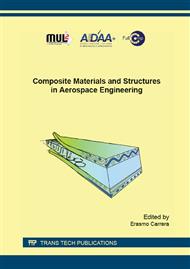[1]
C. -Y. Chia, Geometrically Nonlinear Behavior of Composite Plates: A Review, Applied Mechanics Reviews 41.
Google Scholar
[2]
J. Reddy, Mechanics of Laminated Composite Plates and Shells. Theory and analysis, CRC Press, (2004).
Google Scholar
[3]
S. Wang, A unified timoshenko beam b-spline rayleigh-ritz method for vibration and buckling analysis of thick and thin beams and plates, International Journal for Numerical Methods in Engineering 40 (3) (1997) 473–491.
DOI: 10.1002/(sici)1097-0207(19970215)40:3<473::aid-nme75>3.0.co;2-u
Google Scholar
[4]
Y. Cheung, D. Zhou, Vibrations of moderately thick rectangular plates in terms of a set of static timoshenko beam functions, Computers and Structures 78 (6) (2000) 757–768.
DOI: 10.1016/s0045-7949(00)00058-4
Google Scholar
[5]
D. Zhou, Vibrations of mindlin rectangular plates with elastically restrained edges using static timoshenko beam functions with the rayleigh-ritz method, International Journal of Solids and Structures 38 (32-33) (2001) 5565–5580.
DOI: 10.1016/s0020-7683(00)00384-x
Google Scholar
[6]
H. -S. Shen, Postbuckling of free edge reissner-mindlin plates elastically supported on a two-parameter foundation and subjected to biaxial compression and transverse loads, Engineering Structures 23 (3) (2001) 260–270.
DOI: 10.1016/s0141-0296(00)00038-9
Google Scholar
[7]
M. M. Saadatpour, M. Azhari, M. A. Bradford, Analysis of general quadrilateral orthotropic thick plates with arbitrary boundary conditions by the Rayleigh Ritz method, International Journal for Numerical Methods in Engineering 54 (7) (2002).
DOI: 10.1002/nme.485
Google Scholar
[8]
K. Liew, J. Wang, M. Tan, S. Rajendran, Postbuckling analysis of laminated composite plates using the mesh-free kp-ritz method, Computer Methods in Applied Mechanics and Engineering 195 (7-8) (2006) 551–570.
DOI: 10.1016/j.cma.2005.02.004
Google Scholar
[9]
A. Tamijani, R. Kapania, Buckling and vibration of curvilinearly-stiffened plate subjected to in-plane loads using chebyshev ritz method 1, (2010).
DOI: 10.2514/6.2010-3036
Google Scholar
[10]
R. Rango, F. Bellomo, L. Nallim, A general ritz algorithm for static analysis of arbitrary laminated composite plates using first order shear deformation theory, Journal of Engineering Research 10 (2) (2013) 1–12.
DOI: 10.24200/tjer.vol10iss2pp1-12
Google Scholar
[11]
S. Eftekhari, A. Jafari, A simple and accurate ritz formulation for free vibration of thick rectangular and skew plates with general boundary conditions, Acta Mechanica 224 (1) (2013) 193–209.
DOI: 10.1007/s00707-012-0737-6
Google Scholar
[12]
D. Shaw, Y. Huang, Buckling behavior of a central cracked thin plate under tension, Engineering Fracture Mechanics 35 (6) (1990) 1019–1027.
DOI: 10.1016/0013-7944(90)90129-5
Google Scholar
[13]
E. Riks, C. Rankin, F. Brogan, The buckling behavior of a central crack in a plate under tension, Engineering Fracture Mechanics 43 (4) (1992) 529–548.
DOI: 10.1016/0013-7944(92)90197-m
Google Scholar
[14]
R. Brighenti, Numerical buckling analysis of compressed or tensioned cracked thin plates, Engineering Structures 27 (2) (2005) 265–276.
DOI: 10.1016/j.engstruct.2004.10.006
Google Scholar
[15]
A. Vafai, H. Estekanchi, Parametric finite element study of cracked plates and shells, Thin-Walled Structures 33 (3) (1999) 211–229.
DOI: 10.1016/s0263-8231(98)00042-1
Google Scholar
[16]
A. Vafai, M. Javidruzi, H. Estekanchi, Parametric instability of edge cracked plates, Thin-Walled Structures 40 (1) (2002) 29–44.
DOI: 10.1016/s0263-8231(01)00050-7
Google Scholar
[17]
K. Liew, K. Hung, M. Lim, A solution method for analysis of cracked plates under vibration, Engineering Fracture Mechanics 48 (1993) 393–404.
DOI: 10.1016/0013-7944(94)90130-9
Google Scholar
[18]
J. Yuan, S. Dickinson, Flexural vibration of rectangular plate systems approached by using artificial springs in the rayleigh-ritz method, Journal of Sound and Vibration 159 (1) (1992) 39–55.
DOI: 10.1016/0022-460x(92)90450-c
Google Scholar
[19]
C. Huang, A. Leissa, Vibration analysis of rectangular plates with side cracks via the ritz method, Journal of Sound and Vibration 323 (3-5) (2009) 974–988.
DOI: 10.1016/j.jsv.2009.01.018
Google Scholar
[20]
Y. Kumar, J. Paik, Buckling analysis of cracked plates using hierarchical trigonometric functions, Thin-Walled Structures 42 (5) (2004) 687–700.
DOI: 10.1016/j.tws.2003.12.012
Google Scholar
[21]
T. Dang, R. Kapania, Ritz approach for buckling prediction of cracked-stiffened structures, Journal of Aircraft 50 (3) (2013) 965–974.
DOI: 10.2514/1.c032173
Google Scholar
[22]
H. Lee, S. Lim, Vibration of cracked rectangular plates including transverse shear deformation and rotary inertia, Computers and Structures 49 (4) (1993) 715–718.
DOI: 10.1016/0045-7949(93)90074-n
Google Scholar
[23]
C. Huang, A. Leissa, R. Li, Accurate vibration analysis of thick, cracked rectangular plates, Journal of Sound and Vibration 330 (9) (2011) 2079–(2093).
DOI: 10.1016/j.jsv.2010.11.007
Google Scholar
[24]
A. Milazzo, V. Oliveri, Post-buckling analysis of cracked multilayered composite plates by pb-2 Rayleigh–Ritz method, Composite Structures 132 (2015) 75–86.
DOI: 10.1016/j.compstruct.2015.05.007
Google Scholar
[25]
L.E. Monterrubio, Frequency and buckling parameters of box-type structures using the Rayleigh–Ritz method and penalty parameters, Computers & Structures, 104–105, (2012), 44–49.
DOI: 10.1016/j.compstruc.2012.03.010
Google Scholar
[26]
O. C. Zienkewicz, R. L. Taylor, The finite element method volume 2, Butterworth-Heinemann, (2000).
Google Scholar
[27]
J. Reddy, Energy Principles and Variational Methods in Applied Mechanics, John Wiley & Sons, (2002).
Google Scholar
[28]
K. Liew, C. Wang, pb-2 Rayleigh - Ritz method for general plate analysis, Engineering Structures 15 (1) (1993) 55–60.
DOI: 10.1016/0141-0296(93)90017-x
Google Scholar
[29]
S. Smith, M. Bradford, D. Oehlers, Numerical convergence of simple and orthogonal polynomials for the unilateral plate buckling problem using the rayleigh-ritz method, International Journal for Numerical Methods in Engineering 44 (11) (1999).
DOI: 10.1002/(sici)1097-0207(19990420)44:11<1685::aid-nme562>3.0.co;2-9
Google Scholar
[30]
R. Seifi, N. Khoda-yari, Experimental and numerical studies on buckling of cracked thin-plates under full and partial compression edge loading, Thin-Walled Structures 49 (12) (2011) 1504 – 1516.
DOI: 10.1016/j.tws.2011.07.010
Google Scholar


